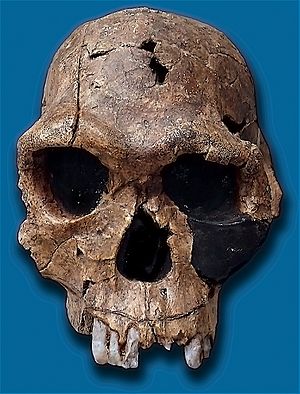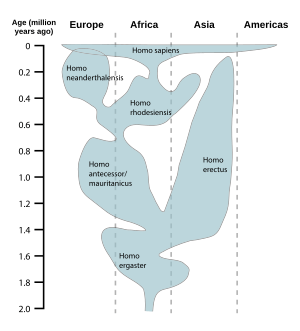Human evolution facts for kids
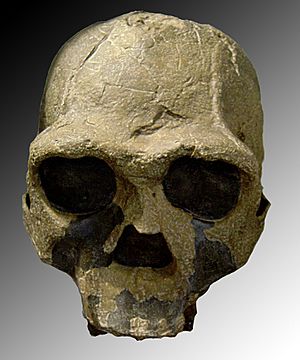
Human evolution is the story of where people came from. All humans belong to the same species. This species started in Africa and then spread across the world. We know this because of the fossils found there.
When we talk about 'human' in this topic, we mean the group of species called Homo. But studies of human evolution also include other early human-like creatures. These are called hominids, like the Australopithecines. The Homo group split off from them about 2.3 to 2.4 million years ago in Africa. The first Homo sapiens, who are the ancestors of people today, appeared around 200,000 years ago.
For hundreds of years, people knew that humans and apes were related. Their bodies are very similar, even with some clear differences. Because of this, scientists like Buffon and Linnaeus grouped them together in the 1700s. Charles Darwin's theory of evolution explains that these basic body similarities come from a shared ancestor. Apes and humans are close relatives. They are both primates, which is an order of mammals that includes monkeys, apes, lemurs, and tarsiers.
Most great apes live in tropical rainforests. Scientists think human evolution began when a group of apes started living more in the savannah. Savannahs are open areas with trees, shrubs, and grass. This group, the australopithecines, began walking on two legs. This freed up their hands to carry things. Life in the open was different, and having bigger brains was a big help. Their brains grew larger, and they started making simple tools. This began at least 5 million years ago. We have fossils of a few different groups of walking apes. One of these groups was the ancestor of humans.
The biological name for "human" is Homo. Modern humans are called Homo sapiens. "Sapiens" means "thinking". So, Homo sapiens means "the thinking man".
Paleoanthropology is the study of ancient human fossils, tools, and other signs of early human life. It started in the 1800s. This was when a skull of "Neanderthal man" was found in 1856.
Contents
How Humans Are Like Great Apes
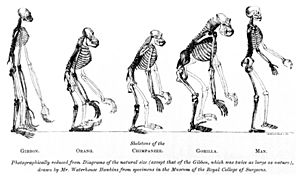
By 1859, zoologists already knew that humans have similar bodies to the great apes. Of course, there are differences too. For example, humans can speak. But the similarities are more basic than the differences. Humans also have body parts that are much older, from very early vertebrates.
The idea that species change over time (evolve) was suggested before Darwin. But his book gave a lot of proof, and many people believed it. The book was On the Origin of Species by means of Natural Selection. It was published in November 1859. In this book, Darwin wrote about evolution in general. He only wrote a little about human evolution. He said, Light will be thrown on the origin of man and his history. But people at the time understood what he meant.
Many people talked about human evolution. These included Thomas Huxley and Charles Lyell. Huxley clearly showed many similarities and differences between humans and apes. He did this in his 1863 book Evidence as to Man's Place in Nature. When Darwin published his own book on humans, The Descent of Man, and selection in relation to sex, the idea of human evolution was already well-known. The theory was controversial. Even some of Darwin's friends, like Alfred Russel Wallace and Charles Lyell, did not like the idea. They found it hard to believe that human intelligence and morals came from natural selection.
Since the 1700s, scientists thought that great apes were closely related to humans. In the 1800s, they guessed that the closest living relatives of humans were either chimpanzees or gorillas. Both live in central Africa in tropical rainforests. It turns out that chimpanzees are indeed our closest relatives. Biologists believed that humans share a common ancestor with other African great apes. They thought that fossils of these ancestors would be found in Africa. And they were right! Now, almost all biologists agree that humans are not just similar to great apes, but are actually a type of great ape.
This idea was proven true in the late 1900s. Studies looked at the proteins and genes in apes and humans. These studies showed that humans share about 95% to 98% of these structures with chimpanzees. This is a much closer relationship than with any other animal. It fully supports what Darwin and Huxley suggested in the 1800s.
Scientists say: "Genetic and fossil evidence generally supports that modern humans started in East Africa. But after that, how humans spread around the world is still quite unclear."
Special Features of Primates
Primates have changed to live in places like trees and bushes. They have many features that help them in these environments. Here are some of those features:
- Shoulder joints that can move a lot in all directions.
- Five fingers and toes on their hands and feet.
- Most have thumbs and big toes that can grasp things.
- Nails on their fingers and toes (in most species).
- Sensitive pads on the tips of their fingers and toes.
- Eyes surrounded by bone.
- A flatter face and a smaller nose. This is because they rely more on sight than smell.
- A complex way of seeing, with both eyes working together (stereoscopic vision). They also have sharp vision and color vision.
- A brain with a well-developed cerebellum for good balance.
- A brain that is large compared to their body size, especially in monkeys and apes.
- An enlarged cerebral cortex (the thinking part of the brain). This helps with learning and solving problems.
- Fewer teeth than earlier mammals.
- A well-developed cecum for digesting plants.
- Two milk glands on the chest.
- Usually one baby at a time.
- A hanging penis and testes in a sac.
- A long time for pregnancy and development.
- A tendency to stand upright, which led to bipedalism (walking on two legs).
Not all primates have all these features. Also, not every feature is only found in primates. Primates often live in social groups with changing power structures.
Other Similarities
Animals that are closely related often have similar parasites. This happens because parasites evolve with their hosts. When host groups split, their parasites often split too. Sometimes, parasites can also move from one species to another. Two very serious human infections in Africa came from apes. Each might have jumped to humans just once.
There are different types of mosquitoes and different types of the malaria parasite Plasmodium. The most serious type, P. falciparum, which kills millions of people each year, came from gorillas. It is now almost certain that chimpanzees are the source of HIV-1, which causes AIDS. We know this by studying the sequence analysis of ape and human viruses.
This shows how similar our bodies are to apes. Their parasites could easily transfer to humans and cause big problems. Humans have less natural protection against these parasites. The parasites are very old, but they are relatively new to our species.
Early Ancestors of the Homo Group
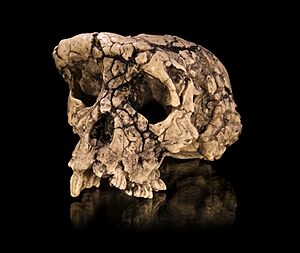
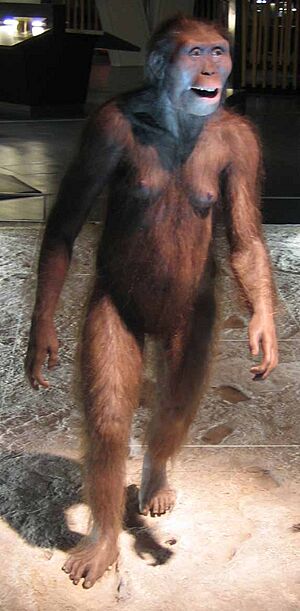
It wasn't until the 1920s that hominid fossils were found in Africa. In 1924, Raymond Dart described Australopithecus africanus. This fossil was called the Taung Child. It was an australopithecine baby found in a cave in South Africa. The remains were a very well-preserved small skull and a cast of the inside of the skull. Even though the brain was small (410 cubic centimeters), its shape was round, more like a modern human brain than an ape's. Also, the fossil had short canine teeth. The position of the foramen magnum (the hole where the spine connects to the skull) showed it walked on two legs. All these features made Dart believe the Taung baby was an early human ancestor. He thought it was a link between apes and humans.
It took another 20 years for scientists to take Dart's ideas seriously. This happened after other similar skeletons were found. At the time, most scientists thought a large brain developed before walking on two legs. They believed that human-like intelligence was needed for bipedalism. But this turned out to be wrong: walking on two legs came first.
The australopithecines are now thought to be direct ancestors of the Homo group. This is the group that modern humans belong to. Both australopithecines and Homo sapiens are part of the group Hominini. But new information suggests that A. africanus might not be a direct ancestor of modern humans. It might have been a cousin. The australopithecines were first put into two groups: gracile (slender) or robust (strong). The robust type of Australopithecus has since been renamed Paranthropus. However, some still see it as a subgroup of Australopithecus.
In the 1930s, when the robust fossils were first described, the Paranthropus group name was used. In the 1960s, the robust type was moved into Australopithecus. Recently, scientists have gone back to classifying it as a separate group.
The Homo Group
It was Carolus Linnaeus who chose the name Homo. Today, there is only one species in this group: Homo sapiens. There used to be other species, but they are now extinct.
The chart shows where some of them lived and when. Some of these other species might have been ancestors of H. sapiens. Many were probably our "cousins". This means they developed on a different path from our direct family line.
Scientists are still trying to figure out the exact family tree. They don't all agree on which should be separate species and which should be subgroups. Sometimes this is because there are very few fossils. Other times, it's because the differences used to classify species in the Homo group are very small.
The Homo group mostly evolved during the Pleistocene epoch. All species in this group are known for using stone tools. At first, these tools were simple. But they became more and more advanced over time. Because of this, in archaeology and anthropology, the Pleistocene is often called the Palaeolithic, or the Stone Age.
Homo habilis
Homo habilis was likely the first species in the Homo group. It developed from the Australopithecus about 2.5 million years ago. It lived until about 1.4 million years ago. It had smaller back teeth (molar) and larger brains than the Australopithecines.
Towards Homo erectus
There are two species that lived from 1.9 to 1.6 million years ago. Their relationship is not yet clear. One is called Homo rudolfensis. We know it from a single incomplete skull found in Kenya. Some scientists think it was just another H. habilis, but this is not confirmed. The other is currently called Homo georgicus. It was found in Georgia. It might be a link between H. habilis and H. erectus, or a subgroup of H. erectus.
Homo ergaster and Homo erectus
Homo erectus was first found on the island of Java in Indonesia in 1891. The person who found it, Eugene Dubois, first called it Pithecanthropus erectus. He thought its body was halfway between humans and apes. Homo erectus lived from about 1.8 million to 70,000 years ago. The older fossils (from 1.8 to 1.2 million years ago) are sometimes seen as a different species or subgroup, called Homo ergaster, or Homo erectus ergaster.
In the early Pleistocene, about 1.5 to 1 million years ago, some groups of Homo habilis in Africa, Asia, and Europe developed larger brains. They also made more complex stone tools. These differences led scientists to classify them as a new species, H. erectus. Also, H. erectus was the first human ancestor to walk truly upright. This was possible because their knees could lock, and the foramen magnum (the hole in the skull for the spine) was in a different place. They might have used fire to cook their meat.
A famous example of Homo erectus is Peking Man. Other fossils were found in Asia (especially Indonesia), Africa, and Europe. Many scientists now use the name Homo ergaster for the fossils found outside Asia. They use H. erectus only for those fossils found in Asia that meet certain requirements for their skeleton and skull. These are slightly different from ergaster.
Neanderthal Man
Homo neanderthalensis (usually called Neanderthal man) lived from about 250,000 to about 30,000 years ago. Sometimes, they are called Homo sapiens neanderthalensis. There is still debate about whether they were a separate species, Homo neanderthalensis, or a subgroup of H. sapiens. While the debate continues, studies of mitochondrial DNA and Y-chromosomal DNA show that very few genes passed between H. neanderthalensis and H. sapiens. This suggests they were separate species. In 1997, Dr. Mark Stoneking, a professor at Pennsylvania State University, said: "These results [from Neanderthal mitochondrial DNA] show that Neanderthals did not give mitochondrial DNA to modern humans… Neanderthals are not our ancestors." More studies of Neanderthal DNA have supported these findings.
A Third Species
Scientists found a piece of finger bone in Siberia. Genetic tests on it gave a surprising result. It is about 40,000 years old. This was a time when Neanderthals and modern humans lived in the area. German researchers found that its mitochondrial DNA did not match either our species or Neanderthals. If this is correct, the bone belongs to a species we didn't know about before. The differences in the DNA suggest this species split off from our family tree about a million years ago. This was long before our species and Neanderthals split.
Homo floresiensis
Homo floresiensis lived about 100,000 to 12,000 years ago. It has been nicknamed hobbit because of its small size. Its small size might be due to island dwarfism. This is when large mammals evolve into smaller forms on islands. H. floresiensis is interesting because of its size and how recently it lived. It is a clear example of a recent Homo species that has features not shared with modern humans. This means H. floresiensis shares a common ancestor with modern humans. But it then split off and followed a different path of evolution. The main discovery was a skeleton thought to be a woman around 30 years old. Found in 2003, it is about 18,000 years old. The woman was estimated to be one meter tall. Her brain volume was only 380 cubic centimeters. This is small even for a chimpanzee. It is less than a third of the average H. sapiens brain, which is 1400 cubic centimeters.
There is an ongoing debate about whether H. floresiensis is truly a separate species. Some scientists believe that H. floresiensis was a modern H. sapiens with a disease that caused dwarfism. Modern humans who live on Flores, the island where the skeleton was found, are pygmies. This fact fits with either idea. One argument against H. floresiensis being a separate species is that it was found with tools only linked to H. sapiens.
Human Arrival on Flores
Stone tools have been found on Flores that are a million years old. These tools are "proxies." This means no human skeletons were found, but only a Homo species could have made these tools. The tools are flakes and other items, 48 in total. Some show signs of being shaped to create a cutting edge. This means humans were on Flores by that time. But it doesn't tell us which species it was.
Homo sapiens
Homo sapiens has lived from about 250,000 years ago until today. Between 400,000 years ago and a warm period around 250,000 years ago, their skulls grew. More advanced stone tools also developed. One idea is that H. erectus slowly changed into H. sapiens. Evidence from Java Man suggests that H. erectus first moved out of Africa. Then, much later, H. sapiens developed from H. erectus in Africa. After that, H. sapiens moved within and out of Africa, eventually replacing the earlier H. erectus.
Out of Africa
Studies of the human genome, especially DNA from the Y-chromosome and mitochondrial DNA, support that modern humans recently came from Africa. Other DNA evidence also supports this idea. The full story of this great journey is still being discovered. But by about 90,000 years ago, humans had moved into Eurasia and the Middle East. This was an area where Neanderthals, Homo neanderthalensis, had lived for a long time (at least 500,000 years in western Europe).
By about 42,000 to 44,000 years ago, Homo sapiens had reached western Europe, including Britain. In Europe and western Asia, Homo sapiens replaced the Neanderthals by about 35,000 years ago. We don't know exactly how this happened.
Around the same time, Homo sapiens arrived in Australia. Their arrival in the Americas was much later, about 15,000 years ago. All these early groups of modern humans were hunter-gatherers.
Current research shows that humans are quite similar genetically. The DNA of different people is more alike than in most other species. This might be because we evolved recently. Or it could be due to the Toba catastrophe. Small groups of people moving into new environments caused some unique genetic traits to appear. These adapted traits are a very small part of the Homo sapiens genome. They include outward features like skin color and nose shape. They also include internal features, like being able to breathe better at high altitudes.
H. sapiens idaltu, found in Ethiopia, from about 160,000 years ago, is a suggested subgroup. It is the oldest known human that looks like modern humans.
Species List
This list shows different species in order of when they appeared.
Related Pages
- ENCODE: a full study of the human genome
Images for kids
-
The hominoids came from a shared ancestor.
-
Fossil hominid evolution display at The Museum of Osteology, Oklahoma City, US.
-
Notharctus tenebrosus, at the American Museum of Natural History, New York City.
-
"A sharp rock", an Oldowan pebble tool, the simplest human stone tool.
See also
 In Spanish: Evolución humana para niños
In Spanish: Evolución humana para niños



